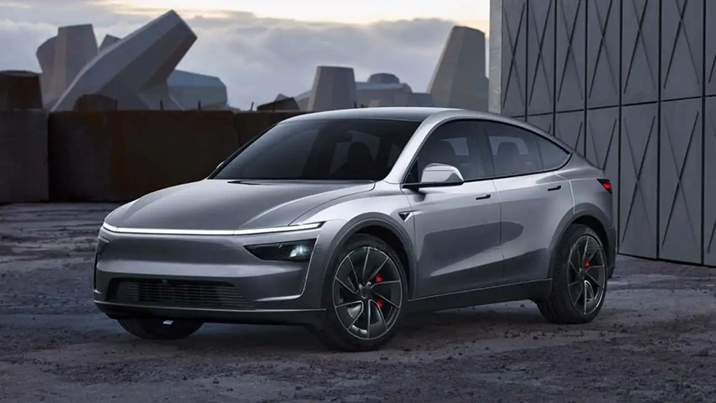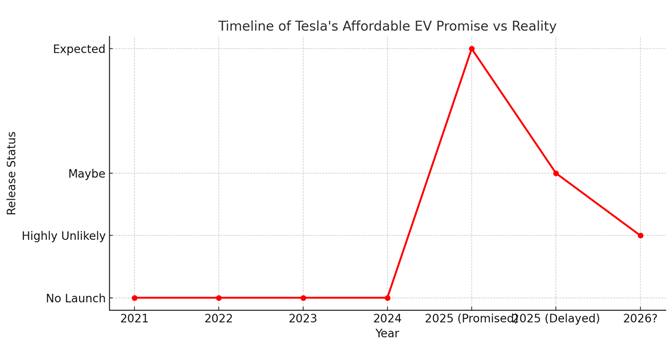For years, Tesla has promised an affordable electric vehicle—something truly game-changing for the mass market. But if you were hoping to buy a $25,000 Tesla soon, it might be time to lower your expectations. Again.
According to a fresh report from Reuters, Tesla is once more delaying its low-cost EV, unofficially dubbed everything from the “Model 2” to the “Model Q.” Internally, it’s called the E41, and the idea behind it was simple: build a smaller, stripped-down version of the Model Y using an already paid-off platform, and pass the savings onto customers. Sounds like a win-win, right?

Unfortunately, Tesla seems to be hitting the snooze button on this plan yet again—pushing the timeline back to late 2025 or even early 2026. That’s a far cry from the company’s earlier claims of a 2025 launch, and for many EV hopefuls, it’s yet another broken promise from a company that has made a habit of bold announcements followed by… well, delays.
The Dream That Keeps Getting Postponed
Let’s rewind a bit. Tesla has long talked about making EVs affordable for the average person—not just tech lovers or luxury buyers. Back in the early days, CEO Elon Musk said a $25,000 Tesla would be a cornerstone of the brand’s mission to accelerate the transition to sustainable energy.
And for a while, it looked like that dream was real. Musk teased new platforms, revolutionary production techniques, and cheaper battery tech that would all make it possible. But fast forward to 2025, and instead of an affordable EV, Tesla has delivered… a $100,000 Cybertruck and more talk about robotaxis—autonomous vehicles that may or may not actually hit the streets anytime soon. So what happened?
It’s no secret that Tesla is facing challenges in 2025. Sales are slowing. EV demand isn’t as hot as it was a couple of years ago. Used Tesla prices are falling fast, and trade-ins are piling up. The brand that once made EVs “cool” is now grappling with brand fatigue and fierce competition from both legacy automakers and new EV startups—especially in China.
The company’s newest product, the Cybertruck, was supposed to shake up the market. But it’s struggled with pricing, production, and public reception. And with fewer than 50,000 units delivered out of more than a million reservations, it’s far from the hit Tesla hoped for.
In this environment, launching a mass-market EV would seem like a smart move. A budget-friendly Tesla could tap into a huge market of buyers who are priced out of current options. But instead, Tesla is still focused on robotaxis and autonomy—concepts that sound exciting but remain years away from reality.

What Happened to the $25,000 Tesla?
Originally envisioned as a purpose-built model from the ground up, the affordable Tesla was supposed to change everything. But Musk scrapped the dedicated design in favor of robotaxi development, pushing back the budget EV idea. Now, the new plan involves a simplified Model Y and a stripped-down Model 3—hardly the revolutionary car fans were hoping for. And even those updated plans seem to be on hold.
The Reuters report didn’t cite a specific reason for the delay. Some speculate it could be due to internal issues, uncertain tariffs, or just a lack of urgency from the top. But no matter the cause, the delay is another blow to those who’ve been patiently waiting for a cheaper way into Tesla ownership.
Let’s be clear—this isn’t just a Tesla problem. It’s a blow to the entire EV adoption movement, especially in the U.S. Tesla is still one of the only automakers consistently producing EVs that people actually want to buy. And while other companies are joining the game, many of their EVs are either luxury-focused or come with compromises in range, performance, or tech.
A truly affordable Tesla could have reset the EV market—giving more people access to electric driving, helping the U.S. compete globally, and pushing other automakers to innovate faster. Now, with the timeline slipping again, those opportunities are also delayed.
Despite the setbacks, Tesla isn’t going away. It’s still a leader in EV tech and continues to dominate in software, charging infrastructure, and brand recognition. But the delay of the affordable EV raises questions about Tesla’s direction—and whether the company is focusing on the right goals at the right time.
Robotaxis may be exciting, but they’re still a dream. Meanwhile, buyers are looking for real cars they can afford now. And with Chinese brands like BYD already selling low-cost EVs with decent tech and range, Tesla risks falling behind in the very race it helped start.
Tesla’s repeated delay of its affordable EV isn’t just disappointing—it’s a missed opportunity. While the company dreams big with autonomy and futuristic tech, many people just want a reliable, affordable electric car they can drive today. And for now, that Tesla still doesn’t exist. The hope is that when it finally arrives—maybe in 2026—it’ll be worth the wait. But in the fast-moving EV world, being late can cost you more than just market share. It can cost you trust.
Related Post
